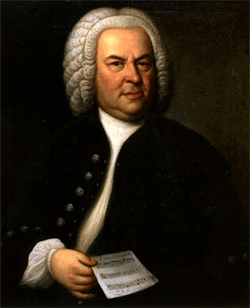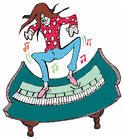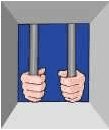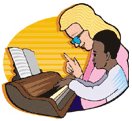Johann Sebastian Bach - Focusing on his Piano Work
Home » Piano History » Johann Sebastian Bach
"The aim and final end of all music should be none other than
the glory of God and the refreshment of the soul."(J.S.Bach)

Bach - for many people was the greatest composer of all times, creating an enormous amount of masterpieces. His music is still alive even after almost 300 years, because of its beauty, harmony, and magnificent melodies.
During his life he was recognized as a great organist,
but as a composer he was not as well known as either Handel or Telemann.
Bach's music was acknowledged only after the historic performance of
"The St Mathew Passion"
in 1829 by Felix Mendelssohn.
Since then, musicians all over the world have been fortunate to study and perform his glorious and heavenly music.
Like many other composers, his greatness was realized only after his death.
Johann Sebastian Bach inspired many composers such as Beethoven who practiced The
Well Tempered Clavier
in all scales, Mozart, who said, when he heard one of Bach's hymns:
"Thank God! I learn something absolutely new!"
His music has motivated many musicians over the years.
Even in other genres such as Rock, Jazz, and Pop music you
can hear the influence of Johann Sebastian Bach.
A few examples can be found in such songs as
"Everything's gonna be alright", by Sweetbox
, and "A whiter shade of pale"
, by the British band Procol Harum,
who both based their music on Johann Sebastians Bach's beautiful piece
"Air on a G string
".
Johann Sebastian Bach as a Child
Johann Sebastian Bach was born in 1685 in Eisanach (in Germany) to a musical family, most of whom held important posts as musicians for the nobility and the church. His father taught him to play the violin and harpsichord when he was a small child.
Tragedy hit him when he was only 9 years old: his mother died, and soon after so did his father.
Johann Sebastian Bach's elder brother took care of him, and gave him a vast musical education in many fields such as learning how to play various musical instruments, to sing (it was said that he had a divine soprano voice as a boy) and even fixing and building organs.
Johann Sebastian Bach the Rebel!

After graduating from school, at the age of 18, he got his first important job as an organist for the St. Boniface's Church in Arnstadt. He was so brilliant and enthusiastic when he was playing, that he added embellishments and improvisations to the choral accompaniment during the prayers. It must have been divine to hear these improvisations, but the church leaders didn't like this at all!
Why?
They wanted the music just to accompany the worshippers, and not to divert their attention. Well, I can quite understand them... you just cannot concentrate on prayers when you hear Johann Sebastian Bach improvising on the organ!
One day, Johann Sebastian Bach heard that the best organist of the time - Buxtehude was playing in a town about 50 miles from where he lived, so he decided to take some time off and to hear him playing. He wanted so much to hear the man that he walked almost of the 50 miles for it!
.
Johann Sebastian Bach prolonged his absence from work in order to spend more time around Buxtehude. The church leaders, already displeased by his embellished playing style, thought that Johann Sebastian Bach had exaggerated by taking some a long leave - so they fired him.
He was already a well known and accomplished organist and he immediately found a new post as an organist at St. Blasiu's in Mulhausen. There he married his first wife Maria Barbara - who gave birth to seven children, of whom only four survived.
Johann Sebastian Bach in prison!
After barely one year in Mulhausen, he became the organist and the concertmaster (the leader of the orchestra) at the court of Duke Wilhelm in Weimar. In this post he had the opportunity to compose for various ensembles, to play and to conduct at many concerts.
After 10 fertile years Johann Sebastian Bach applied for the post of Kapellmeister to Prince Leopold of Anhalt-Cothen. Many composers desired this post because Prince Leopold was known as a music lover, and a musician himself.

Duke Wilhelm was insulted by Johann Sebastian Bach's applying for this post,
jailed him for one month, and dismissed him from his post as
concertmaster at his court in Weimar.
Working at the court of Leopold, the Prince of Cothen (1717-23)
Prince Leopold, who was impressed by Johann Seabastian Bach's talent, hired him.
He paid him well and gave him a free hand in his compositions.
During this period Johan Seasbastian Bach wrote many secular
compositions since the Prince was Calvinist and it was not permitted to elaborate sacred music.
Some of his most famous works were composed during this time,
such as the first book of the Well Tempered Clavier,
the "Brandenburg Concerto
",
"Six Suites for Solo Cello
", and more.
In 1720 Bach's wife suddenly died, leaving him with four children. A year later he married Anna Magdalena - a 17 year old soprano - who gave birth to 13(!!) more children of whom only three survived.
Johann Sebstian Bach in Leipzig (1723-1750)
In 1723, Bach was appointed as cantor and music director of St. Thomas's Lutheran Church in Leipzig. This was a prestigious post that he held for 27 years until his death in 1750. Here, as a religious man, he had the opportunity to serve God with his music since he provided weekly music at two main churches in Leipzig.
Bach was known in Leipzig not only as the town's leader of both secular and sacred music, but also as the town's best music teacher.
Bach's sight deteriorated when he became older, and he was unsuccessfully operated on both his eyes. A few months later he died at the age of 65. Some people say that he died because of complications of the operation, and other say that he had a stroke.
Anyway, he had a rich and spiritual life both as a musician and a family man. Although he died almost 300 years ago his music is still alive and will remain with us for a very long time, if not forever!
Johann Sebastian Bach as a great teacher for keyboard

"There's nothing remarkable about it. All one has to do is hit the right keys at the right time and the instrument plays itself" (J.S.Bach)
Bach was a great teacher for the keyboard. During his lifetime the piano had just been invented and the keyboard instruments of the time were the organ, harpsichord and clavichord. Some of his most famous compositions are actually exercises in which his students practiced various skills in attractive, creative, and beautiful ways on all these instruments.
Today, piano teachers use many of Bach's works for keyboard exercises not only because of their beauty, but because they are methodical and organized by gradual difficulty.
The most famous piano works are the " Notebook for Anna Magdalena Bach (Easiest Piano Pieces) Music Book", " 18 Short Preludes Music Book", " Two Part Inventions 1 - 15, BWV 772 - 786 Music Book" and the "Bentzon - Well Tempered Clavier Opus 157 Music Book", which is the most difficult once.
I, as a piano teacher, have found through the years that students who play Bach's music become good musicians because they are exposed to the best counterpoint ever, and to the unique, special and beautiful harmony in his music.
.The best way in my opinion, for a beginner to be exposed to Bach's music, is to play pieces from the "Notebook for Anna Magdalena Bach". We, in Pianoplayit.com have rearranged some of his works at easier levels so Bach can be played even if you are a total beginner.
Here are some words about each of the books I have mentioned above:
"Notebook for Anna Magdalena Bach"
Anna Magdalena, as we said before, was Bach's second wife. She was a singer and a musician and deeply involved in the musical life of her husband. The "Notebook for Anna Magdalena Bach" is a famous collection of easy pieces for harpsichord or piano, which Bach had dedicated to her.
In the book you will find famous pieces such as "minuet in G", or "Mousette", which we have rearranged at different levels so you can find the one which will suit you. However, there are some pieces that are a bit complicated for beginners, so don't panic - just look and find the piece which is the easiest for you to play. With practice you will be able to try pieces at a higher level.
The next step is the Notebook for Anna Magdalena Bach (Easiest Piano Pieces) Music Book
These works are so beautiful that even advanced players enjoy playing. You can hear Bach's phenomenal harmonic style even in pieces which are not so difficult.
The next step is focusing on counterpoint (writing different musical lines which ran simultaneously):
"Two Part Inventions 1 - 15, BWV 772 - 786 Music Book"
Johann Sebastian Bach gave his students many different exercises but he knew they might get bored.
So what did he do?
He turned some of his exercises into interesting and beautiful short compositions.
There is a total of 30 pieces in this collection: 15 inventions for two voices and 15 inventions in three voices (the latter are called Sinfonias).
Here is what Bach said about this collection: "Honest method, by which the amateurs of the keyboard - especially, however, those desirous of learning - are shown a clear way not only (1) to learn to play cleanly in two parts, but also, after further progress, (2) to handle three obligate parts correctly and well; and along with this not only to obtain good inventions (ideas) but to develop the same well; above all, however, to achieve a cantabile style in playing and at the same time acquire a strong foretaste of composition."
- a bit difficult to understand what he meant but I think he was trying to say that by playing these invention you would be able to grasp three different independent voices at the same time and grow the ability to make such music yourself. Practice makes perfect!
The Inventions are not all easy to play and because of their complexity. My pupils need to study playing the piano for 3-4 years before I teach them how to play the inventions.
And now...the diamond in the crown!
The Well-Tempered Clavier Part II - Henle Urtext - Music Book
This is definitely Johann Sebastin Bach's most extraordinary work for the piano. Generations of composers learned the art of counterpoint by playing and studying this amazing collection of preludes and fugues.
The Well Tempered Clavier is a work in two volumes. Each volume contains a prelude and fugue in every major and minor key, totaling 48 pairs of preludes and fugues.
Beethoven used to practice The Well Tempered Clavier in all scales. Mozart encountered this book when he was 26 years old, and since then he improved his counterpoint technique. Schumann recommended playing one prelude and fugue from the Well Tempered Clavier each day. Chopin's piano teacher taught his students from this book.
I can also tell you a little about my own experience. I write music for orchestras and Big Bands. Studying from this amazing book of Bach has helped me to hear the layers of the music, making it easier for me to compose music for the different instruments in the orchestra.
The fugues in this book require at least 4 -5 years of piano studying, but some preludes are easier - such as the first one which is the most famous:"Prelude in C major". Every pianist should study this piece. It is so beautiful!
Return from Johann Sebastian Bach to Piano History














